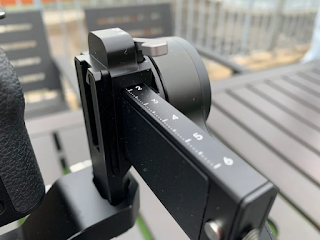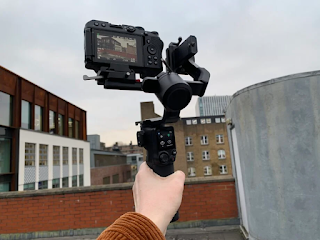DJI RS 3 Mini Camera Specifications
The DJI RS 3 Mini is a powerful stabilizer for installing small mirrorless cameras. The battery life is a bit disappointing, but there are plenty of features to play with and it's more compact and affordable than others in its series.
Key features
Compact and lightweight design DJI RS 3 Mini 795g and measures 180×159×296mm unfolded
Designed for mirrorless cameras can support cameras and a lens up to 2kg
360° rotation with pan axis
DJI Ronin appwith additional features like panorama and interval
Introduction
If you need a new camera stabilizer but object to the idea of pulling around a large hub, the DJI RS 3 Mini could be in your alley.
The RS 3 Mini represents the third installment in DJI's RS 3 line, as it is located below the RS 3 and RS 3 Pro, both physically and in terms of its specifications.
Gimbal is part of DJI's goal to offer professional technology to content creators and can be paired with a wide range of mirrorless cameras.
Keep reading to learn more about the latest (and smallest) RS gimbal from DJI.
design
It's hard to create and balance a gimbal the first time
There is a small touch screen, with some physical controls
The gimbal is small and lightweight for a mirrorless camera but still very heavy
The DJI RS 3 Mini comes with several items in the box that need to be assembled before starting. This includes a tripod extension, a mounting plate, a bolt for connecting the panel and the bracket itself.
If you are familiar with the construction of Ikea furniture, you should be able to find out what is happening by following the wordless schemes in the manual.
Once this is done, the next step is to balance the gimbal. This is the part that I found the hardest the first time I installed the camera, as there are many locks and levers that must be pushed in a certain order to balance properly.
I think this is something that's likely to get easier with practice, as DJI asks its users to rebalance the gimbal every time they hang up a new camera. The company also guides you through the process on the DJI Tutorials YouTube channel, so you can always head there if you forget which lever corresponds to which axis.
The RS 3 Mini itself has a simple black design with gray and red levers and a rubber grip where the rechargeable battery lives.
Most of the controls can be found on a 1.4-inch color touchscreen placed above the handle, but there is also a small set of physical buttons on the gimbal. This includes the power button, the record button and the M button, as well as a trigger and dial on the other side of the handle.
The gimbal also comes with a USB-C port for charging and a NATO port for connecting additional DJI accessories.
From its name, you might assume that the RS 3 Mini will be compact and lightweight – and compare with other hubs in its series. The Mini 180 × 159 × 296 mm measures and weighs 795 grams. For comparison, the regular RS 3 measures 364×187×170mm and weighs 1.3kg, while the RS 3 Pro is larger at 415×218×195mm and 1.5kg.
Despite its compact size, the RS 3 Mini can handle up to 2kg of camera weight and has the added advantage of being easy to fit in a carrying case or small backpack to take on the go.
While the Mini isn't as heavy as other gimbals in the series, it's not exactly lightweight either. It's a good job, the device is designed to keep the cameras stabilizing, otherwise, I think I would have taken a lot of shaky shots in my local park after waving it over my head for an hour. I didn't install a particularly chunky camera and lens, and chose to pair the gimbal with the lightweight Nikon Z30.
Regardless, that doesn't change the fact that this is one of the most lightweight and easy-to-use mirrorless cameras you'll find, at least in the current DJI lineup.
Features and companion app
I had trouble running some camera functions
There are three main installation modes, along with a custom mode and a fun 360-degree time tunnel feature
Users can access more features in the Ronin app
According to DJI, the RS 3 Mini is compatible with most mirrorless cameras. Not only can you stabilize the camera for a more stable video, but you can also use Bluetooth to control the shutter and access other features.
While I found the record button to work fine, I couldn't turn the camera on autofocus when I pressed the button down halfway or to take a picture when I kept the button longer.
Similarly, there is also a large front dial that can be used to access a range of features depending on the camera, including focus, optical and digital zoom, ISO, aperture, and gimbal movements. The only options that seemed to work with my camera were the swivel, tilt, and tilt movements of the gimbal, although this could be a compatibility issue because I know that the zoom feature (to name a few) is only supported on some Sony cameras.
While the lack of camera functionality was a bit annoying, all the gimbal features worked perfectly, including the three main installation modes – PF, PTF, and FPV.
PF (Pan Follow) mode limits gimbal movements on the panning axis and is best for left and right movements. This also happens so that the mode you found is easier to control. PTF (Pan and Tilt Follow) mode retains movement for the swivel and tilt axis and is best used for diagonal shooting, while FPV (Pan, Tilt and Roll Follow) allows movement for all three axes and is designed to flip shots. I found that this was the mode that provided the most freedom of movement but was also the most difficult to control.
You can set custom modes to follow any axis of your choice, but my favorite personal feature was the 3D Roll 360. This mode allows you to hold the handle parallel to the ground and use the joystick to rotate the camera 360 degrees resulting in triple time. Tunnel effect. The rotational movement is incredibly smooth and this is not an effect that you can easily capture anywhere nearby without an axis.
Finally, there's the Ronin app, which offers features like panorama, time lapse, track recording, and the ability to control gimbal using a PS4 or Xbox console. I especially liked how accurate the panorama mode is and I can see that track recording is indispensable for planning shots in cases where you need the camera to go from point A to point B.
Handling & Performance
The stand produces smooth shots at a variety of speeds.
There are multiple ways to control axis movements
The battery drains faster than expected
The DJI RS 3 Mini takes advantage of the DJI's third-generation stabilization algorithm, allowing it to produce smooth footage in a variety of situations. I found that the gimbal tool did a great job of following my arm movements at a variety of speeds and the shots taken with the device were very stable.
You can also adjust the speed manually by choosing between slow, medium, fast and custom speed, ranging from 5-100 in 5 increments. I found that the slow setup was a bit slow and fast it was the hardest to control. Medium showcased a great place between the two, making it my favorite shooting pace.
The Auto-adjust feature in Gimbal determines the rigidity of the axis, but you also have the option to manually adjust any of the three axes using the touchscreen. Meanwhile, Sport mode pushes both to the limits, providing higher sensitivity and speed when activated.
If you struggle to move the axis at certain angles or want to move while placing the device on a table, there is also a joystick. This allows you to move the camera without just one finger and there is also an option to adjust the speed and smoothness in this way.
Finally, there is the push mode, which allows you to actually move the camera to point in any direction when activated.
I found the trigger on the back of the axle very useful for returning the camera to its original position. Pressing the player twice recently turns on the camera, while pressing it three times flips the camera over in selfie mode, essentially allowing vloggers to use gimbal as a stable alternative to the selfie stick.
The only thing I would like to note in this case is that flipping your camera screen is likely to lead to gimbal imbalance, so you'll need to rebalance your camera if you want to see yourself as a vlog.
The last thing worth noting is battery life. The battery charges quickly but I've also found it drains very quickly – that's despite DJI's claims for a 10-hour battery. I've monitored the battery for a number of hours and found that it usually loses about 10% every 30 minutes, which will work for almost 5 hours in total.
I can't imagine that many users will need to output the gimbal for more than five hours at a time. After all, Mini is marketed towards content creators at the expense of filmmakers who record for days at a time. However, you may find that the hub must be left to charge between uses.
Both the RS 3 and RS 3 Pro have a slightly longer battery life of 12 hours, but we have not tested these models ourselves, so we cannot say how accurate this figure will be with actual use.











